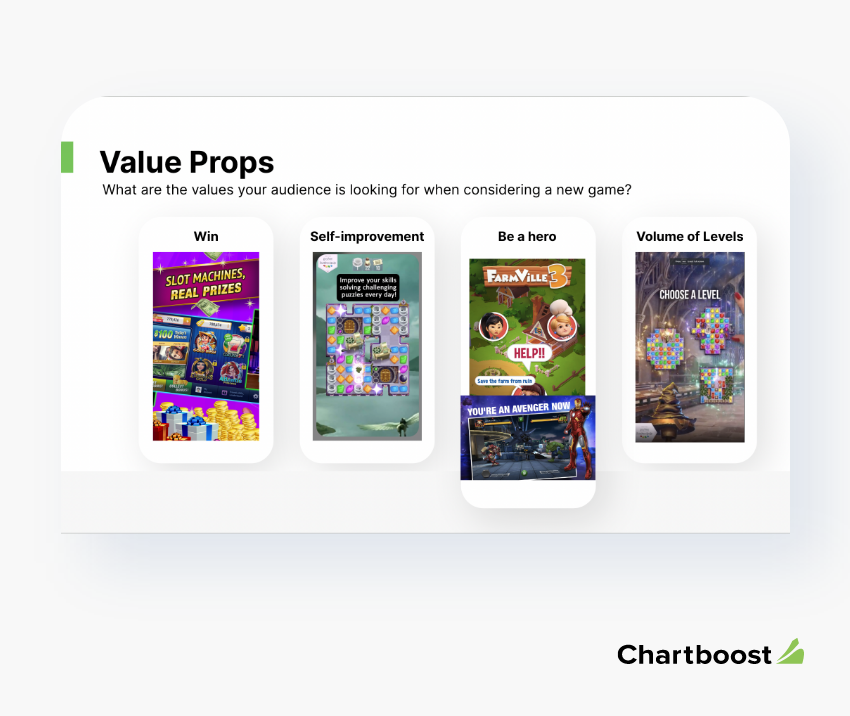The year is 2023, and the world of mobile game user acquisition (UA) has undergone a significant transformation. With privacy guidelines such as Apple’s App Tracking Transparency (ATT) framework and Google’s upcoming Android Sandbox, the days of relying on a steady stream of high lifetime value (LTV) players have vanished. Today, creative expertise takes center stage in mobile game performance marketing, and the emphasis is on quality over quantity. Let’s dive in to unpack this trend.
The old game vs. the new game: From quantity to quality
The old game: Leaning on algorithms for creative performance without understanding the “why”
Once upon a time, mobile UA teams put their faith in several self-attributing networks and delegated the responsibility of selecting high-performing ad creatives to these parties, like Facebook. These networks wielded powerful algorithms that identified high LTV players and determined which ad creatives were most effective in attracting those.
The name of the game was generating hundreds of ad creatives, feeding them into the algorithms, and observing which shone brightest.
However, the ATT framework dismantled the feedback loop between user value and self-attributing ad networks, severely undermining their ability to surface the highest-performing creatives (when taking into account full return on ad spend [ROAS] and revenues). It’s become far more difficult for performance marketing teams to measure which ad creatives are successful. When the effectiveness of these campaigns suddenly deprecated, a serious need arose to gain a new understanding.
The new game: Harnessing creatives as a targeting mechanism
Fast-forward to the present. Ad creatives have become a targeting mechanism. It’s up to UA teams to create ads that captivate the right audience from the get-go. In this new game, ad creatives are tailored to appeal to specific audiences, enabling networks to present those creatives to the users most likely to click and install. Since in-game event data (or the event stream, as some call it) is no longer communicated, aside from very early signals from SKAN, ad creatives account for the vast majority of data the algorithms have to work with.
But just because users are more likely to respond to ad creatives (by clicking or installing) doesn’t mean they will necessarily offer value in LTV and retention. In something of a role-reversal, it’s now up to performance marketing to supply demand partners with the creatives that will attract their top audience.
Networks are no longer sent a bunch of creatives from which they send back data identifying high-value players for a specific game. It’s actually the opposite — the network uses creatives to find an audience for which it resonates. It’s then up to the game publisher’s performance marketing team to conclude whether that creative delivered a valuable audience or not.
By designing different creatives for different audiences, marketers “fish” for audiences within a specific pool of supply.
This shift has ushered in a new era of creative expertise from performance marketing teams that includes the ability to ideate, plan, produce, measure, and analyze ad creatives — a muscle that has atrophied over the years but now must be rebuilt.
Building a strong foundation: Ideation and planning
The first step toward mastering creative expertise involves ideation and planning. UA teams must identify the audience correlated with high LTV and derive inspiration from the ad creative components that resonate with this audience by running intelligent creative and comprehensive research. Simply copying the creative strategy of a different game won’t cut it anymore.
Understanding your audience
Before diving into ad creation, it’s essential to understand your target audience’s preferences, habits, and behaviors. What type of content do they engage with? What are their reasons for playing mobile games? Which other genres are they playing (their genre-to-genre affinity), and what are the commonalities between these genres and your game? Answering these questions will help you design ad creatives that appeal to your audience.
Crafting a compelling story and theme
The story and theme of your ad creative plays a crucial role in capturing your audience’s attention. Create a narrative that reflects your game’s unique selling points while sparking interest and curiosity. Leveraging the most compelling points for the audience you’re trying to attract is a core reason they will respond.
Selecting the right visual style and value propositions
The visual style of your ad creative can make or break its success. Choose an art style that appeals to your target demographic and stands out in the crowded mobile gaming market.
An entire category of mobile UA ad creative emerged (fake ads) that used styles from other genres to attract and acquire users with a high probability of liking a certain game because they’re attracted to one specific game mechanic.

Pair this with value propositions that emphasize the benefits and unique features of your game, motivating users to click and install.
The art of analysis: Measuring and evaluating ad performance
Once your ad creatives are live, it’s essential to evaluate their performance and uncover insights that can inform future campaigns. In the era of SKAN 4.0 and other emerging tools, UA teams must rely on a combination of methodologies to understand the real impact of their ad creatives. There isn’t one source of truth yet in this new era, rather a combination of methodologies that can be used for triangulation.
Top-of-funnel metrics: Clicks and installs
At the top of the funnel, metrics such as click-through rate (CTR) and install rate (IPMs) are useful indicators of your ad creative’s ability to attract users. By closely monitoring these metrics, you can identify the creatives that are resonating with your audience and make data-driven decisions about which ad variations to prioritize. However, that’s only half the story.
Bottom-of-funnel metrics: Revenues and retention
While top-of-funnel metrics provide valuable insights, it’s crucial to examine how your ad creatives impact bottom-of-funnel metrics, such as ROAS, revenues, and retention. To accomplish this, employ methodologies such as media mix modeling and incrementality analyses, together with deterministic-attribution where possible, which can help you gauge the true influence of your ads on user behavior and long-term engagement.
Dissecting ad creative performance
Understanding why a particular ad creative performed well is vital for replicating success in future campaigns. Break down the ad’s components — story/theme, mechanics, art style, value propositions, and messaging — to identify what contributed to its performance. This analysis will help you uncover patterns and insights that can inform your creative strategy moving forward.
Try to understand why it attracted the audience you were targeting, and come up with hypotheses that you can improve on.
Iterating and learning from experience
As you analyze performance for ad creatives, apply your learnings to future campaigns. Continually iterate and refine your ad creatives based on data-driven insights to improve their effectiveness over time. This process of continuous improvement will help you stay ahead of the competition and maximize the return on your UA investments.
The future of mobile game UA: Creative expertise is the ultimate weapon
In the new landscape of mobile game UA, creative expertise has emerged as a critical skill for success. Performance marketing teams that invest in cultivating their abilities in ideation, planning, production, measurement, and analysis of ad creatives will be well-equipped to navigate the challenges of 2023 and beyond. It’s a rare, hard-to-achieve mix of skills that if mastered, will give you a strong competitive advantage.
By embracing creative expertise as a targeting mechanism, mobile game publishers can attract the right audience and thrive in this rapidly evolving environment. The journey to mastery won’t be easy, requiring time, dedication, and a willingness to learn from both successes and failures. The payoff, however, is well worth the effort.
So, roll up your sleeves and get ready to dominate the mobile game UA arena. With the right blend of creative expertise and data-driven insights, you’ll be well on your way to claiming your place atop the leaderboard.



